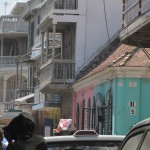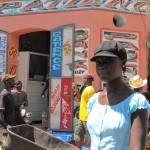Well, you may or may not know that I went to Haiti last week. It was quite an adventure to say the very least. Traveling there is unlike any travel experience I have ever had. The trip starts with a Gua Gua out of Puerto Plata. A Gua Gua is a small 20 passenger bus. They pack them as full as sub-humanely possible and you ride shoulder to shoulder with a stranger for an hour. We then had two more Gua Guas and a Tap Tap when we got into Haiti. A Tap Tap is the same thing in Haiti OR it can be a small pick up truck with a camper shell and two benches in the back. We were fortunate not to have to ride in the back of a truck. Crossing the border wasn’t as bad as I thought it was going to be, but then again we got really lucky. You only have to pay if you are a Gringo. Luckily, as we were walking across two huge trucks went across at the same time and we managed to get through without paying. There are no real border restrictions. Haitians and Dominicans can come and go across the border whenever they want. If the border is closed and you need to get across you need only to swim across the river underneath. If you don’t want to swim you can get in a wheel barrow and be pushed across by a Haitian or one will pick you up on their shoulders and carry you across.
At this point you might be asking “Amber, why don’t more Haitians just cross the border into the Dominican Republic?” Well, I’ll tell you. Dominicans don’t like Haitians. Haiti has invaded the Dominican Republic twice. One time they occupied for 25 years and closed all the schools and opened all the prisons. Dominicans have been let’s say upset at Haitians ever since. Haitians that do live in the DR are poor. They live in Agua Negra and Playa Westa. They also form their own sort of towns in the abandoned sugar cane fields.
When you cross the border in DaJambon the first thing you see is a big muddy feild filled with motos. They swarm you and pull you to get on their bike. James, Dove’s Haiti Director, decides which ones we take and tells them where we need to go and before you know it you’re off. Roads in Haiti are the most trecherous. For every 5ft. of cement there is 10ft. of pot holes. It is terrible to drive on. I wanted to look around, but was afraid that at any moment I would fall off if I didn’t pay attention. There were people everywhere, most just getting out of church. From there we got on our last Tap Tap and made it into Cap Haitian.
Cap Haitian wasn’t hit by the earthquake. Port Au Prince was the city destroyed by the quake, Cap Haitian just felt the tremors. However, it is very much a city distressed. There are people everywhere. Many buildings are made in the French two story style; think New Orleans French Quarter. The buildings, however, are made of cement and if people live in them they live upstairs. Often there are no doors or windows, it’s almost as if they are squarters. Below are usually stores. You can’t tell what stores are what because they aren’t usually marked. If they are marked it might be an old sign. Many people sell things on tables or out of wheel barrows on the side walk. A quick fact about the side walk. The roads are lined be ditches full of trash and sewage. The sidewalks are are all along these ditches and one misstep will land you in a pool of disease. Not to mention there is trash everywhere. There is no public sewage or trash program.
This is my first glance of Haiti. We will call this part one.



